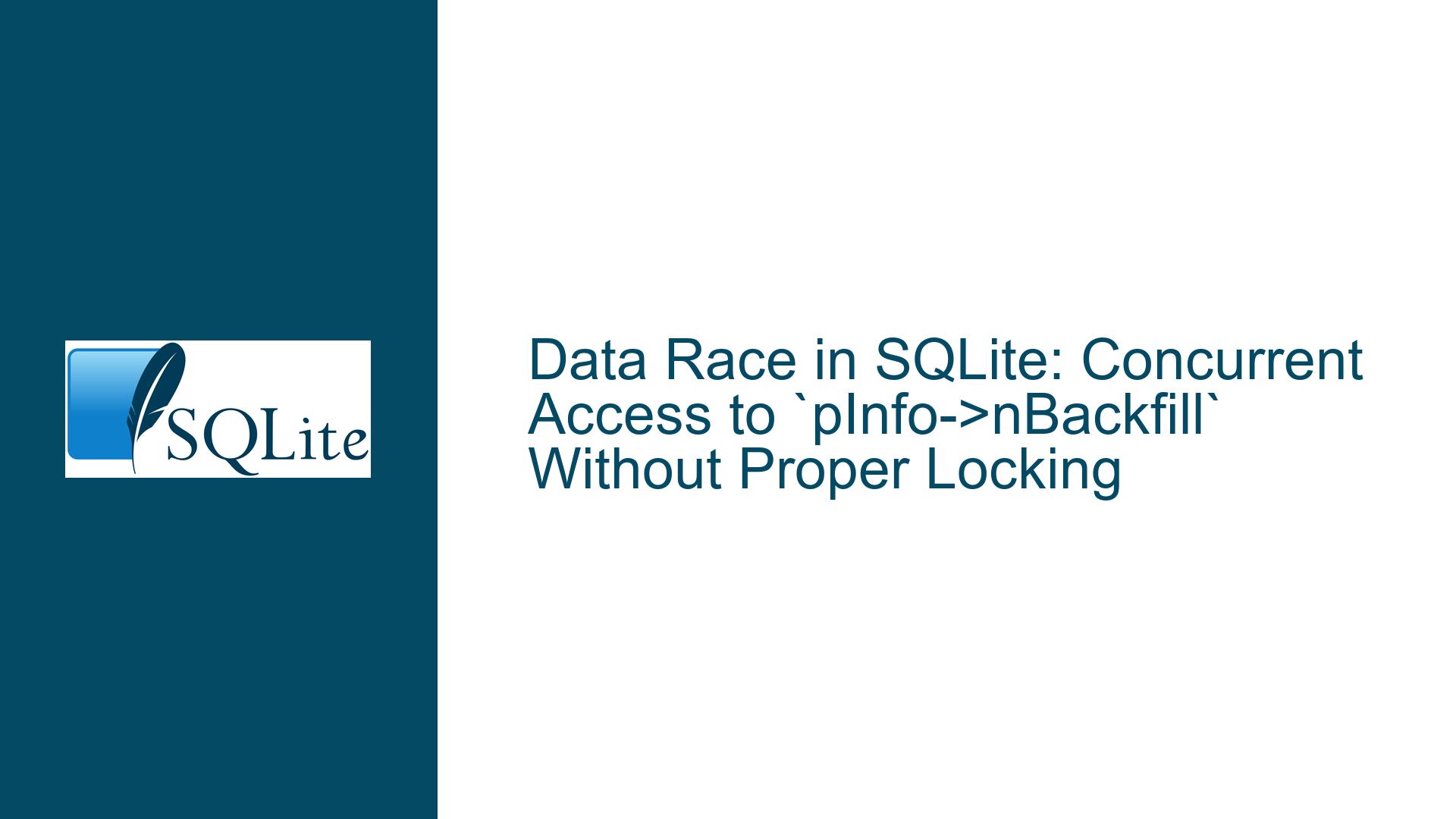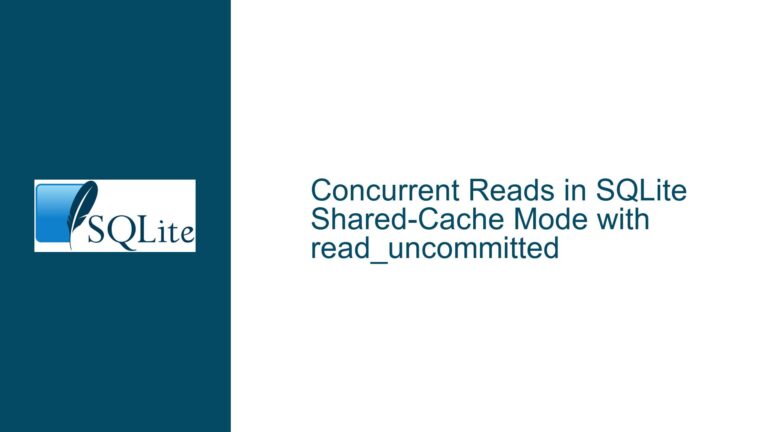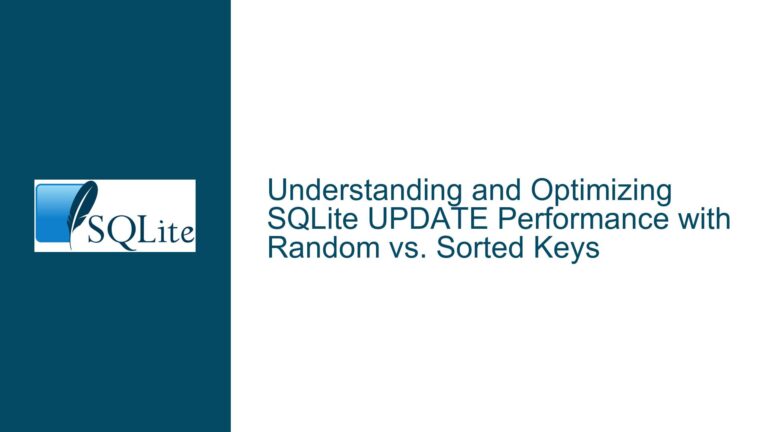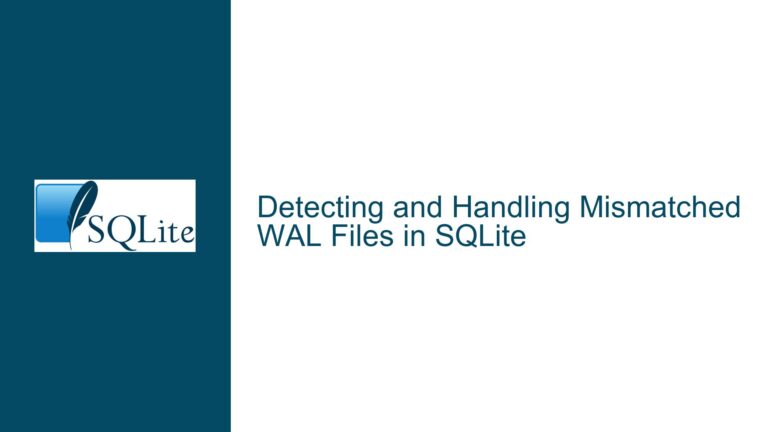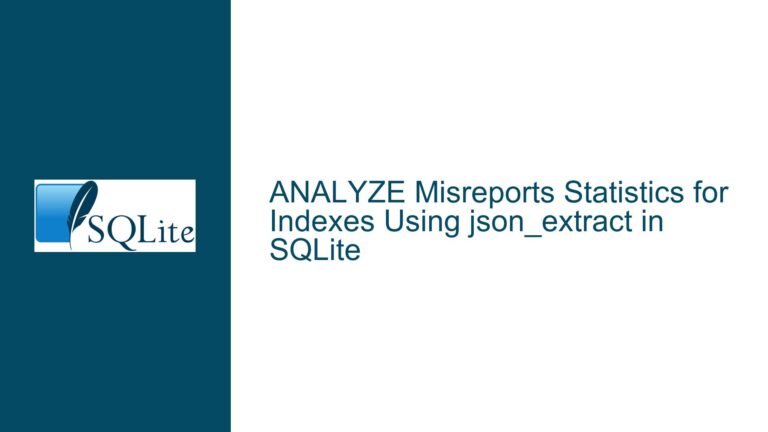Data Race in SQLite: Concurrent Access to `pInfo->nBackfill` Without Proper Locking
Concurrent Access to pInfo->nBackfill in WAL Mode
The issue revolves around a potential data race condition in SQLite’s Write-Ahead Logging (WAL) mode, specifically involving the shared-memory variable pInfo->nBackfill. This variable is part of the WAL shared-memory segment, which is accessible by multiple processes or threads. The race condition arises when two threads attempt to access pInfo->nBackfill concurrently without proper synchronization. Thread 1 reads pInfo->nBackfill to compare it with pWal->hdr.mxFrame, while Thread 2 writes a value of 0 to pInfo->nBackfill. These operations occur in different call stacks but can execute simultaneously, leading to undefined behavior if not properly serialized.
The problem is particularly concerning because pInfo->nBackfill is a critical component of SQLite’s WAL mechanism. It tracks the number of frames that have been backfilled from the WAL to the main database file. If this value is corrupted due to a race condition, it could lead to inconsistencies in the database, such as missing or incorrectly applied transactions. The issue was identified using a fuzz-testing tool called connzer, which detected the lack of explicit locking mechanisms around the accesses to pInfo->nBackfill.
The core of the problem lies in the assumption that file locks alone are sufficient to serialize access to shared-memory variables like pInfo->nBackfill. While file locks are indeed used to coordinate access between processes, they may not provide adequate protection in scenarios where multiple threads within the same process access shared memory concurrently. This oversight can lead to race conditions, especially in high-concurrency environments where threads frequently interact with the WAL.
File Locks Failing to Serialize Shared-Memory Access
The primary cause of this issue is the reliance on file locks to serialize access to shared-memory variables like pInfo->nBackfill. File locks are designed to coordinate access between different processes, ensuring that only one process can modify the database at a time. However, they do not provide thread-level synchronization within a single process. This limitation becomes apparent in multi-threaded applications where multiple threads within the same process access shared memory concurrently.
In the case of pInfo->nBackfill, Thread 1 and Thread 2 operate within the same process but execute different functions that access the variable. Thread 1 reads pInfo->nBackfill as part of the walTryBeginRead() function, while Thread 2 writes to pInfo->nBackfill in the walRestartHdr() function. Since file locks do not prevent these threads from accessing the variable simultaneously, a race condition occurs.
Another contributing factor is the lack of mutexes or other thread-synchronization mechanisms around the accesses to pInfo->nBackfill. While SQLite uses mutexes extensively to protect other critical sections of the code, this particular variable appears to have been overlooked. This omission suggests a gap in the thread-safety guarantees of SQLite’s WAL implementation, particularly in high-concurrency scenarios.
The issue is further compounded by the fact that the race condition is difficult to detect under normal testing conditions. It requires a specific sequence of events, such as concurrent execution of walTryBeginRead() and walRestartHdr(), to trigger the race. This makes the problem particularly insidious, as it may go unnoticed until it causes data corruption in a production environment.
Implementing Mutexes and Enhancing File Lock Mechanisms
To address this issue, a combination of mutexes and enhanced file lock mechanisms should be implemented to ensure proper serialization of access to pInfo->nBackfill. The following steps outline the recommended approach:
Introduce Mutexes for Thread-Level Synchronization: A mutex should be added to protect access to
pInfo->nBackfillwithin the same process. This mutex would ensure that only one thread can read or write the variable at a time, preventing race conditions. The mutex should be acquired before accessingpInfo->nBackfilland released immediately afterward. This change would require modifications to bothwalTryBeginRead()andwalRestartHdr()functions.Enhance File Lock Mechanisms for Process-Level Synchronization: While file locks are effective for coordinating access between processes, they should be supplemented with additional checks to ensure that they are functioning correctly. For example, SQLite could verify that file locks are properly acquired before accessing shared-memory variables. This would help catch any issues with file lock implementation or configuration.
Add Debugging and Logging for Race Condition Detection: To aid in the detection and diagnosis of race conditions, SQLite should include additional debugging and logging mechanisms. These could include logging the acquisition and release of mutexes and file locks, as well as recording the state of shared-memory variables like
pInfo->nBackfill. This information would be invaluable for identifying and resolving race conditions in production environments.Conduct Thorough Testing in High-Concurrency Scenarios: The changes outlined above should be thoroughly tested in high-concurrency scenarios to ensure that they effectively prevent race conditions. This testing should include stress tests with multiple threads and processes accessing the database concurrently. Any issues identified during testing should be addressed before the changes are deployed to production.
Document Best Practices for Multi-Threaded Applications: Finally, SQLite’s documentation should be updated to include best practices for using the database in multi-threaded applications. This would help developers avoid common pitfalls and ensure that their applications are thread-safe.
By implementing these changes, SQLite can significantly reduce the risk of data races involving shared-memory variables like pInfo->nBackfill. This would enhance the reliability and robustness of the database, particularly in high-concurrency environments.
Detailed Analysis of the Proposed Solutions
1. Introducing Mutexes for Thread-Level Synchronization
The introduction of mutexes is a critical step in addressing the race condition involving pInfo->nBackfill. Mutexes provide a mechanism for thread-level synchronization, ensuring that only one thread can access a shared resource at a time. In this case, a mutex would be used to protect access to pInfo->nBackfill, preventing concurrent reads and writes.
The implementation of mutexes would involve the following steps:
Define a Mutex for
pInfo->nBackfill: A new mutex, such aspInfo->nBackfillMutex, should be defined in the WAL shared-memory structure. This mutex would be initialized when the shared-memory segment is created.Acquire the Mutex Before Accessing
pInfo->nBackfill: In bothwalTryBeginRead()andwalRestartHdr(), the mutex should be acquired before accessingpInfo->nBackfill. This would ensure that only one thread can read or write the variable at a time.Release the Mutex After Accessing
pInfo->nBackfill: After the access is complete, the mutex should be released to allow other threads to access the variable.
The following pseudo-code illustrates the changes:
// Define the mutex in the shared-memory structure
struct WalSharedMemory {
// Other fields...
sqlite3_mutex *nBackfillMutex;
// Other fields...
};
// Initialize the mutex when creating the shared-memory segment
void walCreateSharedMemory() {
// Other initialization code...
pInfo->nBackfillMutex = sqlite3_mutex_alloc(SQLITE_MUTEX_FAST);
// Other initialization code...
}
// Acquire the mutex before accessing pInfo->nBackfill
void walTryBeginRead() {
sqlite3_mutex_enter(pInfo->nBackfillMutex);
// Access pInfo->nBackfill
sqlite3_mutex_leave(pInfo->nBackfillMutex);
}
void walRestartHdr() {
sqlite3_mutex_enter(pInfo->nBackfillMutex);
// Access pInfo->nBackfill
sqlite3_mutex_leave(pInfo->nBackfillMutex);
}
2. Enhancing File Lock Mechanisms for Process-Level Synchronization
While mutexes address thread-level synchronization, file locks are still necessary for process-level synchronization. However, the current implementation of file locks may not be sufficient to prevent race conditions in all scenarios. To enhance the file lock mechanisms, the following steps should be taken:
Verify File Lock Acquisition: Before accessing shared-memory variables, SQLite should verify that the appropriate file locks are acquired. This would help catch any issues with file lock implementation or configuration.
Add Timeout Mechanisms for File Locks: In high-concurrency environments, file locks may become contended, leading to delays. Adding timeout mechanisms can help prevent deadlocks and ensure that processes do not wait indefinitely for locks.
Log File Lock Activity: Logging the acquisition and release of file locks can provide valuable insights into the behavior of the database in production environments. This information can be used to diagnose and resolve issues related to file locks.
The following pseudo-code illustrates the changes:
// Verify file lock acquisition before accessing shared-memory variables
void walTryBeginRead() {
if (!sqlite3_file_lock_acquired(pWal->pDbFd)) {
// Handle error: file lock not acquired
}
// Access pInfo->nBackfill
}
void walRestartHdr() {
if (!sqlite3_file_lock_acquired(pWal->pDbFd)) {
// Handle error: file lock not acquired
}
// Access pInfo->nBackfill
}
3. Adding Debugging and Logging for Race Condition Detection
Debugging and logging are essential tools for identifying and resolving race conditions. By adding detailed logging mechanisms, SQLite can provide developers with the information they need to diagnose and fix issues in production environments.
The following steps outline the recommended approach:
Log Mutex Acquisition and Release: Logging the acquisition and release of mutexes can help identify contention and potential deadlocks. This information can be used to optimize the use of mutexes and improve performance.
Log File Lock Activity: As mentioned earlier, logging file lock activity can provide insights into the behavior of the database in high-concurrency environments. This information can be used to diagnose issues related to file locks.
Record the State of Shared-Memory Variables: Logging the state of shared-memory variables like
pInfo->nBackfillcan help identify inconsistencies and potential race conditions. This information can be used to verify that the database is functioning correctly.
The following pseudo-code illustrates the changes:
// Log mutex acquisition and release
void walTryBeginRead() {
sqlite3_mutex_enter(pInfo->nBackfillMutex);
sqlite3_log(SQLITE_LOG_DEBUG, "Mutex acquired in walTryBeginRead");
// Access pInfo->nBackfill
sqlite3_mutex_leave(pInfo->nBackfillMutex);
sqlite3_log(SQLITE_LOG_DEBUG, "Mutex released in walTryBeginRead");
}
void walRestartHdr() {
sqlite3_mutex_enter(pInfo->nBackfillMutex);
sqlite3_log(SQLITE_LOG_DEBUG, "Mutex acquired in walRestartHdr");
// Access pInfo->nBackfill
sqlite3_mutex_leave(pInfo->nBackfillMutex);
sqlite3_log(SQLITE_LOG_DEBUG, "Mutex released in walRestartHdr");
}
4. Conducting Thorough Testing in High-Concurrency Scenarios
Thorough testing is essential to ensure that the changes outlined above effectively prevent race conditions. The following steps outline the recommended approach:
Stress Tests with Multiple Threads: Stress tests should be conducted with multiple threads accessing the database concurrently. These tests should simulate high-concurrency scenarios to identify any potential race conditions.
Stress Tests with Multiple Processes: In addition to multi-threaded tests, stress tests should also be conducted with multiple processes accessing the database concurrently. This would help verify that the file lock mechanisms are functioning correctly.
Long-Running Tests: Long-running tests should be conducted to identify any issues that may arise over time. These tests should simulate real-world usage patterns to ensure that the database remains stable under sustained load.
5. Documenting Best Practices for Multi-Threaded Applications
Finally, SQLite’s documentation should be updated to include best practices for using the database in multi-threaded applications. This would help developers avoid common pitfalls and ensure that their applications are thread-safe.
The documentation should include the following topics:
Thread-Safe Configuration: Developers should be advised to configure SQLite for thread-safe operation, including enabling the appropriate compile-time options and runtime settings.
Proper Use of Mutexes: Developers should be advised to use mutexes to protect shared resources, such as shared-memory variables and database connections.
Handling File Locks: Developers should be advised to handle file locks correctly, including acquiring and releasing locks in the correct order and handling lock contention gracefully.
Debugging and Logging: Developers should be advised to use debugging and logging mechanisms to identify and resolve issues in production environments.
By following these best practices, developers can ensure that their applications are robust and reliable, even in high-concurrency environments.
Conclusion
The data race involving pInfo->nBackfill in SQLite’s WAL mode is a serious issue that can lead to data corruption in high-concurrency environments. The root cause of the problem is the reliance on file locks to serialize access to shared-memory variables, which does not provide adequate protection for multi-threaded applications. To address this issue, a combination of mutexes and enhanced file lock mechanisms should be implemented, along with additional debugging and logging to aid in the detection and diagnosis of race conditions. Thorough testing in high-concurrency scenarios and updated documentation on best practices for multi-threaded applications are also essential to ensure the reliability and robustness of the database. By taking these steps, SQLite can significantly reduce the risk of data races and enhance its performance in high-concurrency environments.
